There’s this strange trend showing up, primarily on Instagram, of people asking/demanding that muralists get tagged on social media — even if the artists’ names are perfectly visible in the photograph, or if the mural lacked any tag. I’ve seen it on others’ posts. It’s happened a few times with my own.
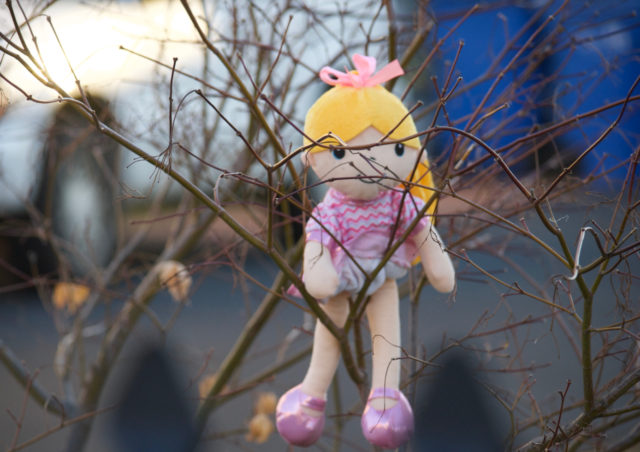
I don’t enjoy it.
That might sound strange coming from me. For years I taught students how to attribute information. The assumption, then, might be that I would expect a very specific format to be followed. That assumption would be incorrect. As I would tell my students, while certain formats are required in specific contexts, the important idea is that if they did not write the words or create the image, then they needed to somehow indicate this to show integrity. If a music artist samples another, the norm is to credit in the liner notes. When a word artist uses someone else’s letters, the norm is to give footnotes or link back to the source. I created an entire map showing where different art is located in Hartford, and people can return to the site to see who may or may not have signed it.
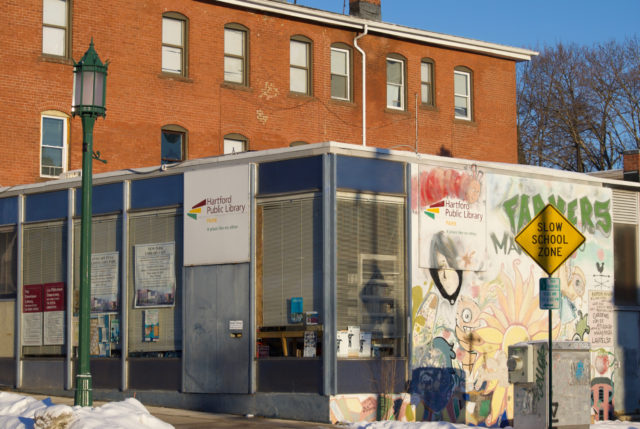
Here’s my issue with these new, stringent “requirements” — they seem to elevate a particular kind of art over all the other art that I encounter daily, which often has unknown artists. It feels elitist.
When it comes to street photography, I am nearly always showing something that others have created — from homes to skyscrapers to gardens. I don’t recall anyone asking me why I did not, when posting a photograph of a house, credit the home’s architect. But having grown up in a blue collar family of carpenters, electricians, HVAC technicians. . . I have to ask why people don’t find it necessary to give credit to the person who wired the streetlamps or painted a home that they have photographed and Instagrammed. When showing an image of a bridge, nobody has scolded me for not naming its designer. At most, they ask where it is, not who made it.
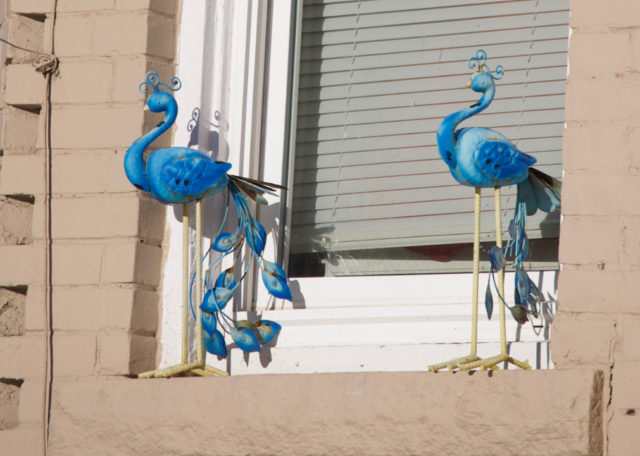
Maybe you don’t find these fabulous peacocks or the installation of that doll in a winter bare tree to be art, but would likely recognize the gold-leaf covered sculpture atop one of the flag poles around the Old State House as art.
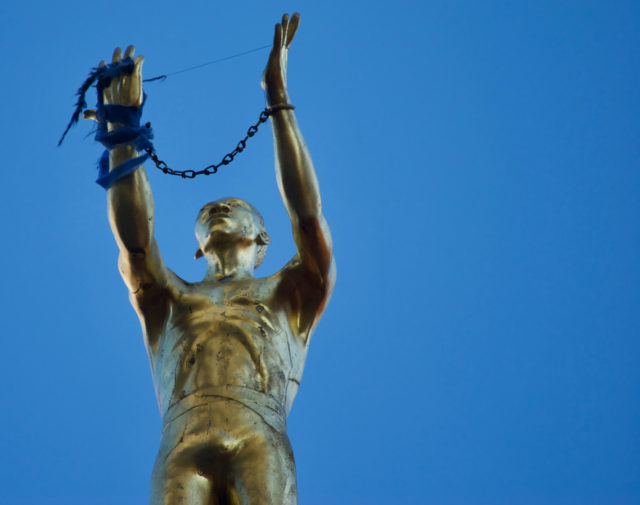
This is the kind of image I have posted a number of times yet nobody has suggested that I tag the artist.
How could that information even be known?
Maybe there is a sign somewhere on the museum’s grounds telling who the figures are and who created them, but I could not find it. If the sculptor’s name is etched on the artwork itself, it can’t really be seen from the ground, at least not with my zoom lens.
After a little research back at home, I was able to learn that the likeness of Joseph Cinque was created by Randall Nelson. I don’t know who is responsible for the addition of what looks like a piece of cloth, but my guess is either the wind or a crow. Maybe a gull.
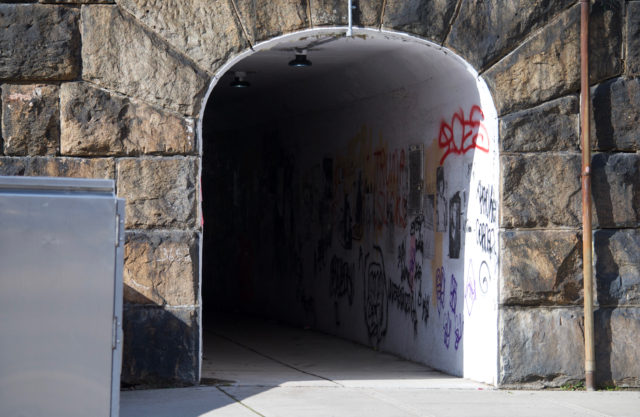
I look at this tunnel next to Bushnell Park and see a non-curated gallery, with a range of skills on display. The photographs pasted inside — the best of the work, in my opinion — are now worn, and if a name was present, it’s now hard to find. Others have scrawled over the top. Paper exposed to the elements has torn and faded.
The graffiti scrawled over the top of some images — was it placed by the photographer or someone else?
It’s public art, and it’s hard to know who is responsible for what.
That’s okay. It’s not art cloistered inside a traditional gallery.
By the way, who installed those stones? I’d like to know their names.
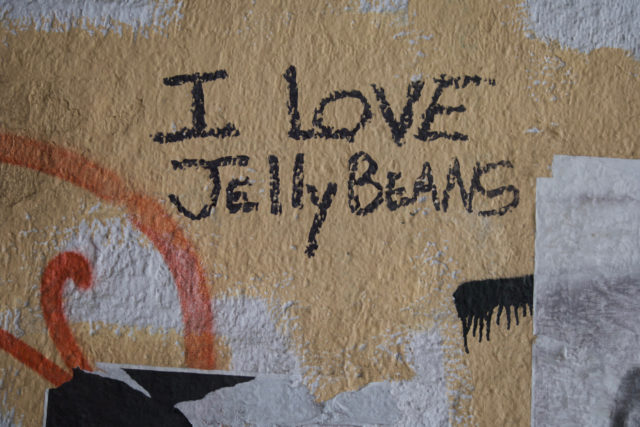
Who is to say that the declaration of love for JellyBeans (the candy? a person? someone’s cat?) is less worthy than a cartoonish mural with multiple artists?
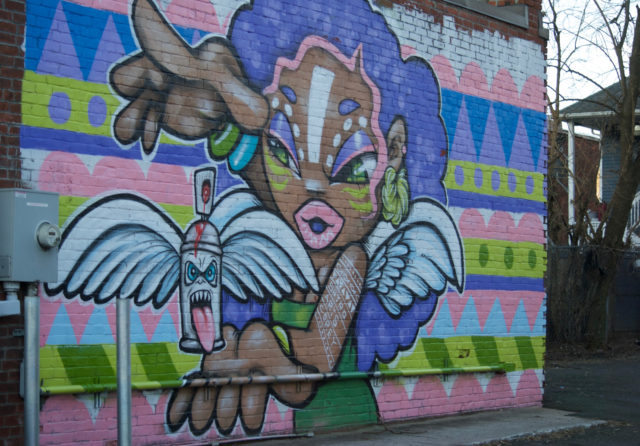
It took me a minute to figure out which artists were involved with the mural on Broad Street, but still have no idea who is responsible for the JellyBeans love. . .and to be honest, the simple statement of affection makes me smile.
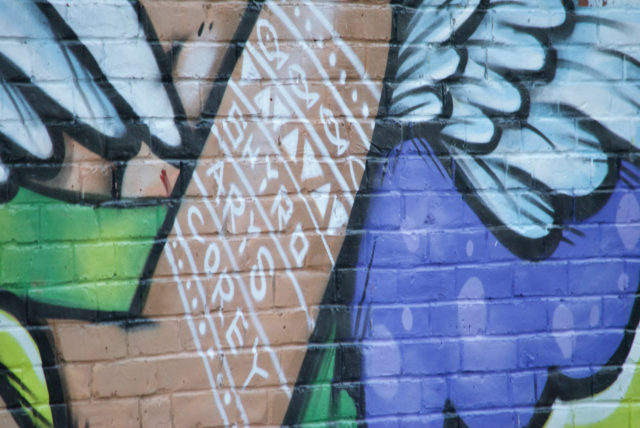
Across the street from this mural are a few buildings with eye-catching and skillful paint jobs. I could not say who painted either, but I enjoy how Pepe’s and Hermana’s are both memorable and not boring beige.
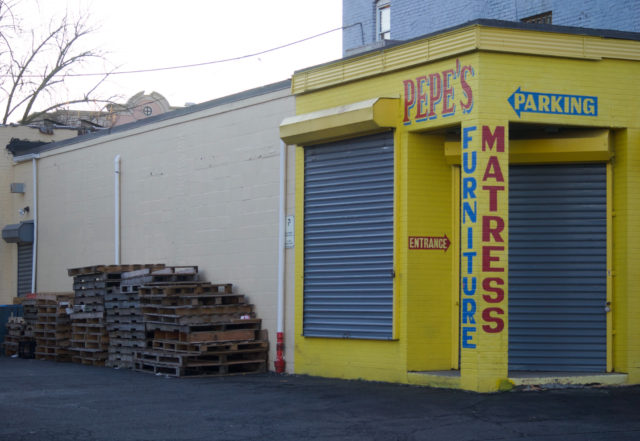
Much of what I post on Real Hartford is material that I consider art, even if no one else does, and if you look back through the Look! series, it may become more obvious.
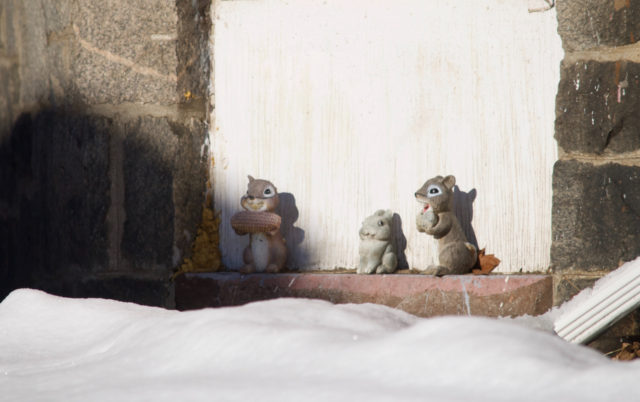
Here’s another one: sandwich boards. Who would the credit even go to? This one is outside of Hartford Prints! but no person’s name is at the bottom. Do we credit the person who thought up the content, or the person who physically created it, if those people are different?
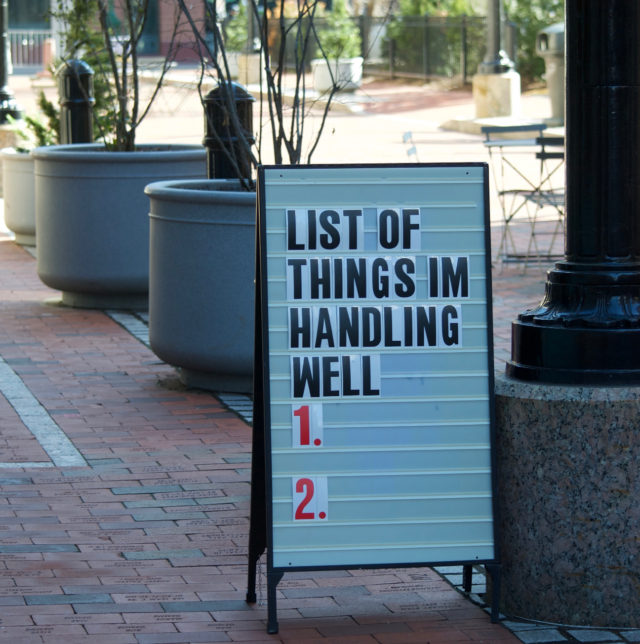
Unpopular opinion alert: I don’t love Sol LeWitt. Why? Because while he may have conceptualized artwork, others brought/bring it to life. But who gets the credit? Look at pretty much any social media post. Go ahead. Take ten minutes and search his name on Instagram or Facebook. You are not likely to find a list of a dozen or so volunteers who did the actual painting.
I guess my point is that there is this purist or perfectionist tendency that has emerged about attribution, but it’s incredibly flawed and excludes worker bees, those who did not attend art school, those who are more interested in creating than anything else, those who are making things without necessarily thinking of their projects as Art.
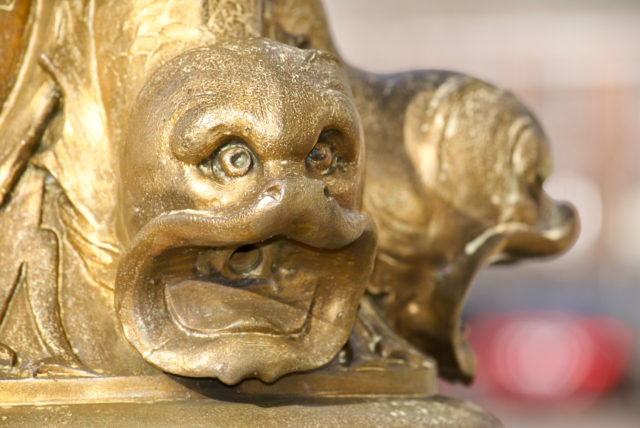
There are two water fountains in front of City Hall. Even after looking through newspaper archives, I have no better idea of who sculpted these fabulously creepy figures. For something this odd and cool, I expected to find a bit of an origin story, or at least a colorful description. If I wanted to sacrifice my lunch breaks at work, I could probably find a record somewhere, but that’s access the average person does not have at their fingertips.
Yet a fountain in Pope Park, which has since been converted from fountain to flower planter, received plenty of attention in the press. A sketch of it was published while fundraising was still underway. George Keller designed this memorial, which was originally installed on Park Terrace at Capitol Avenue, within view of his residence. It was moved beside the Pope Park Rec Center’s parking lot because of the icky road redesign that followed the installation of I-84, and now it gets tagged routinely.
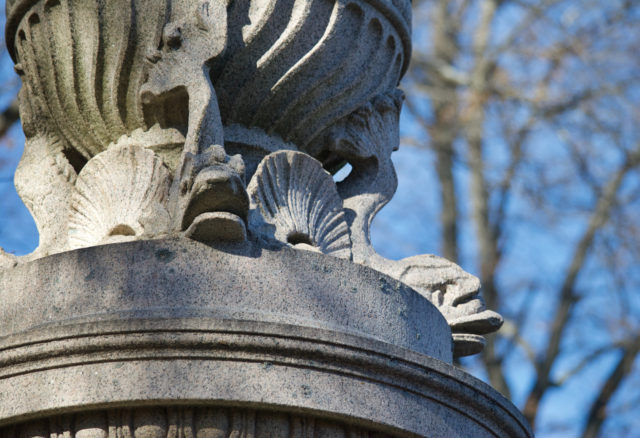
Art needs not fit into a very narrow mold, and attribution methods should not be forced into one either — just so long as nobody is trying to pass off someone else’s work as their own.
Oh, and that mural at the top of the post? It’s on the Sanchez School facing Grand Street. I have no idea who created it.
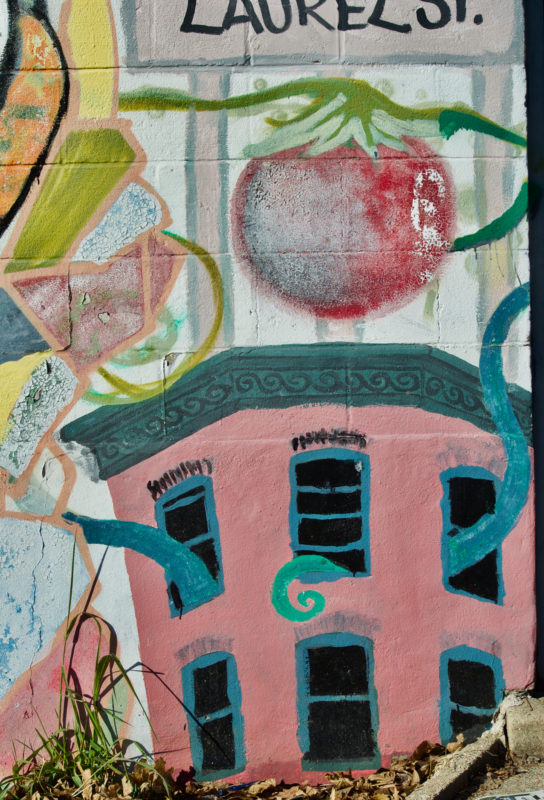
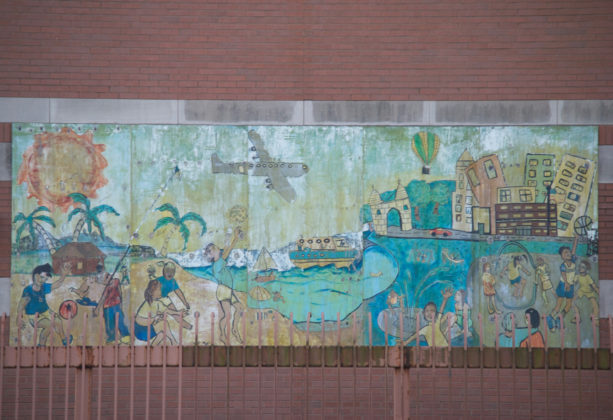
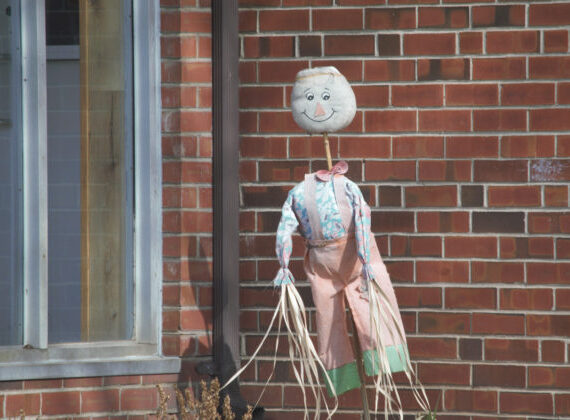

Richard Nelson
How can anyone be brief with such a great article? Here is my comment split in two.
This is the type of article that one would expect folks in the artistic circles of Hartford to take up and discuss. Let’s see if they are going to be as boring as the next artist and sit quietly twirling their thumbs. As I travel about and spot some of the new mural activity or see photos I can only say, much too much overly saturation that may cause strong women and men to become afflicted with Stendal syndrome confused by their hallucinations of what they think to be beauty or even art and end up on the sidewalk with folks asking, “Are you ok?” I am not impressed by much of the mural activity and upfront I would be ashamed to have my name attached to any of it. It is such an odd bunch of “those were the days.”
Many years ago, before tagging or graffiti entered the public domain I use to tag. Back in those days, one place to tag was the men’s rest rooms coast to coast, maybe writing, “looking for a quickie,” leaving something witty, a drawing perhaps of private parts and what you would do, I use to write, “Artist has been here once, did a job and left.” In a way paying homage to Piero Manzoni’s 1961 work, Merda d’artista. But here we get to the part where a thinking cap is needed. The artist has been here once, did a job and left, asks us, who is this artist? What did artist do here? I see no art. Must have flushed? Was that artist’s art? No full bowl to mark the spot or make the next guy scream. Was artist satisfied with being anonymous? Was artist satisfied there was no art to be purchased? No fame to have. Did the swear rats benefit with what was in the flush? See this does not stop it. The Merda d’artista is now in the Tate. It is stopped in history.
Ours continues on. This is what some of us expect from art. When I began sticking out my thumb some 50 + years ago, leaving art school, trained, (Woof Woof, good boy Rover), as a painter one had to make choices. Do I lug with me paints and canvas or sleeping bag and other survival objects. One had to then bring their art thought to other places, many of the places Kerri mentions in this excellent article. It is articles like this that can certainly help folks shake off the old and think in new ways. Not just a ha ha for a second or two, not just a plaything and then on to old way art, but as real art thought that will certainly liberate anyone. Truly we need more liberated folks from the old ways.
Richard Nelson
(This is part two of the comment. Thank you Kerri for allowing me to not be brief. Either I am a fool or just a long winded old bat.)
Underground artists for years who are trying hard to break down art and capitalism have been doing works that are anonymous. We all have heard the phrase “Anonymous was an artist.” Works that cannot be attributed to anyone person. Not a part of the game plan. I sometimes question all of that. Is that not the old way, the way of Capitalism? The way of putting the “me” out in front. Getting rid of the “me” is not asking for anything but that the person who comes upon the work enjoy it. Of course, so many folks who say, “I am artist,” want to get paid. Want fame and followed by fortune? Want to be a part of the history books. Want their name up in lights or the very least a pat on the back from others in the claiming circle. I once wrote the lines; A thousand ants carry a dead beetle home. So where does that art leave the humans? Did I get paid? No. Did I enjoy every second of the art? A big Yes. Did I help to move a person from the old to the new. I sure hope so. I was working at the time, mopping floors, and enjoying the evaporation of the water as the floor dried. Some of us have no art we just do everything the best that we can. At least I got paid for passing that mop and freed myself many times over. Though I don’t eat Jelly Beans the “I love Jelly Beans” writings is a favorite of mine. Far better in my opinion then all of the murals painted all over the city by anyone of the hundreds in the claiming game.
Karl Marx no relation to Groucho, though in some circles he has been accuse of being a grouch said these words.
“In a communist society, there are no painters, but men who among other things do painting. Being a painter is to be subjected to the division of labor as much as it one only did weaving. every person in communist society is relieved of the burden of narrowness which plagued his or her ancestors, weavers and painters alike, and given the opportunity to express him or herself in all possible ways.”
Those of us who are still working for that utopia that new day do not wish to bring anything not even a sleepy seed into the new day. This is hard, one of the hardest jobs I have ever set out to do.